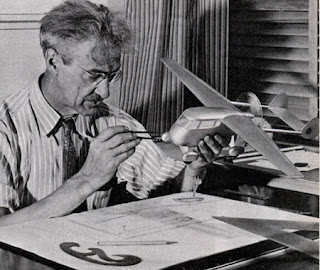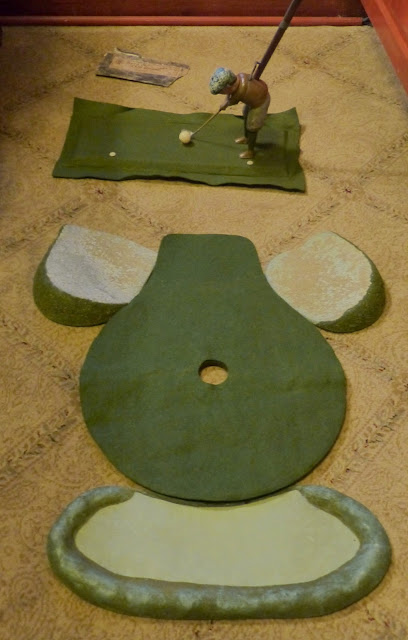Prosperity abounded in the 1920's which gave Americans more leisure time. How did golfers entertain themselves in the off-season during the roaring twenties? How about imbibing in a prohibited potent potable? Perhaps. But for the risk averse, there were many other ways to entertain. Radio, motor car touring, flagpole sitting, and Ouija were popular pastimes. The miniature golf craze was just taking off in the early '20's. Interest grew throughout the twenties with about 40,000 miniature golf courses by 1930. With crowds packing these "pygmy" courses, William Stout, of Dearborn, Michigan, thought of a solution. Why not create a miniature course in your own home? But, with a miniature course at home, a full human swing would have broken many a Tiffany lamp. So, Stout came up with the idea of changing the club so that it can only take a miniature swing. He came up with two types of models, both of which used a lever to move a club at the bottom of the shaft. One club used a clubhead that was similar to a regular golf club. While keeping the main shaft stationary, the player simply pulls the lever embedded in the grip which then swings the attached clubhead in a miniaturized arc that is more suitable for indoor use. A second version uses a small figurine attached to the bottom of the shaft which swings a miniature club. Patents were issued on March 14, 1922.
 Stout was better known for his designs and inventions for the automobile and aeronautics industries working for the Packard Motor Co.. He was the founder of Aviation (Aerial) Age magazine. He started his own airplane manufacturing company called the Stout Metal Airplane Company, which was purchased by Henry Ford. Modern Mechanix magazine claimed that he was credited with more inventions than any man since Edison.
Stout was better known for his designs and inventions for the automobile and aeronautics industries working for the Packard Motor Co.. He was the founder of Aviation (Aerial) Age magazine. He started his own airplane manufacturing company called the Stout Metal Airplane Company, which was purchased by Henry Ford. Modern Mechanix magazine claimed that he was credited with more inventions than any man since Edison.
Stout's idea needed a manufacturer and promoter, so he looked at The Schoenhut Company, which had been manufacturing toys since 1872. Originally founded by Albert Schoenhut, the Philadelphia based toy company produced high quality miniature toy pianos and other instruments. They eventually produced wooden dolls as well.
A set of circus related wooden figures accompanied by other circus items called the Humpty Dumpty Circus was a huge seller for the company. In the early 1900's, Schoenhut became the largest american toy producer.

 |
| Sissie Lofter & Tommy Green at the short 1st hole |


As a side note, the term, "tee box", seems to have originated from an actual box at the teeing ground that had a dual duty. First, the yardage of the hole and hole number were displayed on the box. Second, the box was filled with sand. Nowadays, some courses have sand filled boxes to replace divots taken from the teeing ground. But the sand from these vintage tee boxes was actually used to create a golf tee. The golfer or caddie would wet some sand from the water filled bucket, scoop some sand from the box, either bare handed or with a conical metal scoop, and then plunk down the sand to create a mound to elevate the ball. The 'hole' ritual became quite an art...and a mess. Why not just use a wooden golf tee? Simple - tees were not readily available until about 1924.
 |
| Golfer at North Berwick adjacent to a tee box |
 |
| Schoenhut's Tee Box |
 |
| Sissie Lofter |




The game appeared yet again in 1990's, with a more mature version of Arnold Palmer.
The latest reincarnation of the game is now made by M. I. Golf, reverting back to the classic Arnie look. Founder Jay Danner has a nice collection of videos to hone your shot making skills as well as a historical summary of the game. Give it a try - hitch up your trousers and "go for broke"!





















